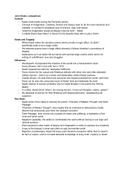John Keats; comparison.
Context
- Keats wrote poetry during the Romantic period
- Concept of imagination, creativity, dreams and beauty seen to be far more important and
valuable, in contrast to analytical uses of science, logic and reason
- "what the imagination seizes as Beauty must be truth" - Keats
- 'La Belle Dame Sans Merci' is french for the beautiful lady with no pity (i think)
Keats and Tragedy
- Whilst Keats writes his narrative poems which provide a tragic effect, he didn't
specifically seek to be a tragic writer
- His selected poems have a tragic effect whereby it follows Aristotle's conventions of
tragedy
- Keats grew up in an idyllic life but struck with several tragic events which led to his
writing of unfulfillment, love and struggles
Influences
- Wordsworth; incorporated the miseries of the world into a transcendent vision
- Fanny Brawne; fell in love with her in 1819
- Keats' experiences with her; obstacles/ fulfilment
- Fanny known for her casual and flirtatious attitude with other men and often attended
military dances - said to be a tease and deliberately stoked Keats' jealousy
- Charles Brown, his best friend and someone who helped published his works; didn't like
Fanny as he saw she consumed much of Keats' time and distracted his work
- Keats' distrust of women (probably why he made females in his poems the 'femme
fatale')
- In a letter, Keats wrote "when I am among women, I have evil thoughts, malice, spleen"
- He despised of women for their flirtatious and teasing behaviour, reawakening old
suspicion
Key Ideas
- Keats wrote of two ideas to express his poetry: 'Chamber of Maiden Thought' and 'Dark
Passage'
- 'Chamber of Maiden Thought'; idea implies that an individual is distracted by bodily
desires that temporarily give them the 'pleasant wonders'
- 'Dark Passage', then moves into a phase of misery and suffering, a realisation of the
cruel and harsh world
- Negative Capability; the ability to contemplate the world without having to use logic and
rational systems
- Poet required to enter realm of beauty and imagination in order to express true creativity
- A way to find beauty in what was often an ugly and terrible world
- Rejection of philosophy, Keats felt every poet should be receptive rather than to search
for fact or reason, and to not seek absolute knowledge of every truth, mystery or doubt
, La Belle Dame Sans Merci
Context
- Keats wrote this poem in 1819 after falling in love with Fanny Brawne
- Might explain his desire to express romantic love and sensuality
- Also since Fanny attended several military dances, probably explains the specific
characterisation of the 'knight-at-arms'
- Since she was known to be flirtatious and provoked many males, may also explain the
dream the knight has of other 'pale warriors' who were victims of her seduction?!
Intentions for writing La Belle Dame Sans Merci
- Perhaps wanted to express three main ideas:
- Physical/ material love is temporary (as it is in a material world... - think Plato and Cave
analogy)
- Women who lead men on are cruel (Keats clearly has trust issues)
- Love is damaging (desire for wish-fulfilment, to seek true love)
Language, Form and Structure
- It is a ballad, idea of folklore; often used for myths/ fairytales
- As a sensual poet, he portrays his ideas of 'negative capability' across in this poem
- Use of repetition
- Those 'pale': 'palely loitering', 'death pale' and 'pale warriors'
- The spiritual fairy: 'a faery's song', 'a faery's child'
- Told in retrospect with the knight as the narrator
- Is his narrative reliable since he is armoured as suggested by the 'knight-at-arms' and
has a 'lily on thy brow' indicating that he is near death (since most people near death
hallucinate and what not)
Summary
- A knight is found to be 'palely loitering' and another voice questions him as to why he is
in his state 'on the cold hill's side' where 'no birds sing'
- The 'knight-at-arm' explains how he saw a beautiful 'faery's child' and the encounter he
had with her
- Knight had a dream that others involved with the 'faery's child' had also been deceived
by her
- After awakening, he finds himself alone, not in the 'elfin grot' he had been left inside of
but 'on the cold hill's side' (clearly he was hallucinating or imagining this 'faery' and 'elfin
grot')
- Therefore, that is why the knight is left 'on the cold hill's side'
Setting
- Use of pathetic fallacy, 'on the cold hill's side', 'the harvest is done' and 'no birds sing'
- Death is near, life is withering away - like the state of the 'knight-at-arms'
Protagonists, Femme Fatale and Victims
- After going through the poem several times, it came apparent to be that the role of the
protagonist is actually debatable
- Whilst the knight-at-arms may be presented as the immediate tragic protagonist since he
is the narrator, he seems to put in so much effort to woo the 'faery's child' by creating
garlands and what not




